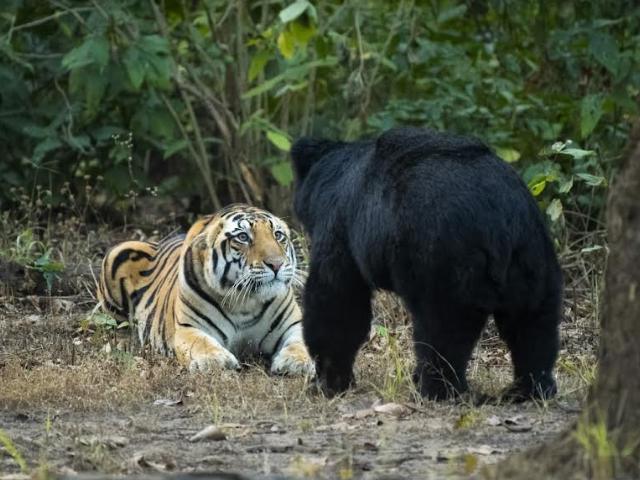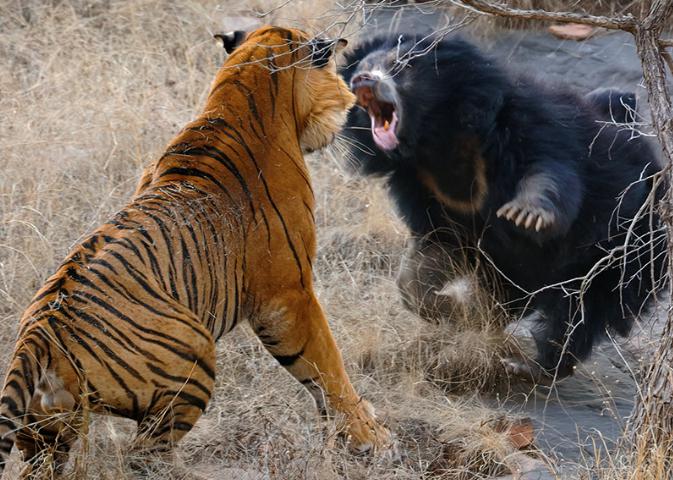Tiger may be the king of jungle but occasional images coming out from Tadoba-Andhari tiger reserve and Ranthambore national park also display dominance of sloth bear over the big cats. On World Bear Day-March 23, we highlight the strength of our Indian Bhaloo or the sloth bear (Melursus ursinus) , a myrmecophagous bear species native to the Indian subcontinent. When the bhaloo stands on its rear feet and growls loudly, the tiger beats a retreat.
Epic Battles Shot On Camera
Bear is As Threatened As Tiger
Can a bear kill a tiger? Experts’ instant reply is always “NO”. The tiger occasionally prey on bears depending on its size and weight. But they add, “ a bear always gives a tough fight and the tiger, being the king of the jungle, would never give up. Fiercely fought fights may end in a draw as we have seen on numerous occasions including the one in Ranthambore national park and Tadoba tiger reserve. But others differ. There are few cases of the fight between the two and resulted in the death of the tiger. If it has not happened during the fight, the bear leaves the tiger so battered that it dies after sustaining severe injuries from the long deadly bear claws.
Also read: Tiger Corridor : Now Satpuda Melghat National Parks Connectivity At Risk
The sloth bear (Melursus ursinus) is a myrmecophagous bear species native to the Indian subcontinent. It feeds on fruits, ants and termites. It is listed as Vulnerable on the IUCN Red List, mainly because of habitat loss and degradation .Bear paws are disproportionately large, and have highly developed, sickle-shaped, blunt claws which measure 10 cm ( 4 inches) in length. The tiger claws are also of the same size and can grow upto 4 inches (10 centimeters) long, and are used to grab and hold onto their prey. The IUCN (International Union for Conservation of Nature) estimates that fewer than 20,000 sloth bears survive in the wilds of the Indian subcontinent and Sri Lanka. The sloth bear is listed in Schedule I of the Indian Wildlife Protection Act, 1972, which provides for their legal protection. Commercial international trade of the sloth bear (including parts and derivatives) is prohibited as it is listed in Appendix I of the Convention on International Trade in Endangered Species.
Bear Against Tiger
Tigers’ main strengths are their sense of sight, stalking and hearing rather than smell when hunting prey. They cautiously stalk their prey from the rear in an attempt to get as close as possible to their unsuspecting prey. Then they attempt to take down their prey with a powerful bite to the neck or throat. Bengal tigers occasionally prey on sloth bears. It is not uncommon to find sloth bear fur in tiger scats. Tigers typically hunt sloth bears by waiting for them near termite mounds, then creeping behind them and seizing them by the back of their necks and forcing them to the ground with their weight. Tigers are capable of knocking down larger prey like adult gaur ( 450 kg to 1000 kg) and wild water buffalo but will also opportunistically kill and eat much smaller prey, such as monkeys, peafowl and other ground-based birds, hares, porcupines, and even fish.
Also read:Bhopal's Urban Tigers Need Tiger Reserve Not Chain-Links Mr Chief Minister
The big cat also deceives its prey and are known to mimic the calls of sambar deer (Rusa unicolor) to attract them, sloth bears react fearfully even to the sounds made by deer themselves. Like other animals it can surprise a bear from the back but when it comes to facing a bear head on, the tiger avoids confrontation. When confronted face to face by a tiger , sloth bears many times stand and stretch their front feet displaying deadly claws. And while doing so , a threatened bear roars and growls loudly. Tiger usually retreats from an assertive sloth bear, as the bear's claws can inflict serious wounds, and most tigers end the hunt if the bears become aware of the tiger's presence before the pounce. Occasionally sloth bears may scavenge on tiger kills.
Cover image courtsey Naman Agrawal (@naman289). Other Three pictures courtsey Aditya Dicky Singh(@adityadickysin)





Comments
Post a Comment